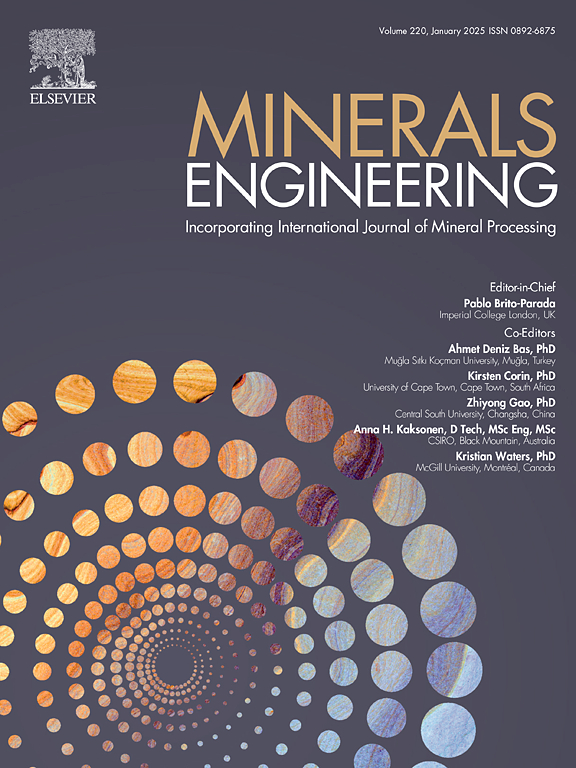Improving the flotation performance of fine molybdenite using superhydrophobic magnetic carriers
IF 4.9
2区 工程技术
Q1 ENGINEERING, CHEMICAL
引用次数: 0
Abstract
Effective flotation recovery of fine molybdenite is a significant challenge. This study investigated the role of superhydrophobic magnetic carriers (SMC) in improving the flotation recovery of fine molybdenite. Flotation tests of actual molybdenum ore showed that the addition of SMC can significantly improve the recovery of −38 μm molybdenite, especially −19 μm molybdenite, with a 14 % increase in recovery. Pure molybdenite flotation tests showed that the flotation speed of fine molybdenite in the early stage of flotation (0–1 min) was significantly faster in the presence of SMC than in the absence of SMC, and its flotation recovery (52.9 %) in 1 min is even slightly higher than that (51.3 %) in 3 min in the absence of SMC. Optical microscopy analysis confirmed that SMC adsorbed fine molybdenite particles, forming SMC-molybdenite agglomerates that facilitated carrier flotation. Calculations based on the EDLVO theory indicated that hydrophobic agglomeration was predominantly driven by hydrophobic potential energy, which was two to three orders of magnitude greater than electrostatic and van der Waals interaction potentials at interaction distances of 30 nm and 20 nm, respectively. The hydrophobic potential energy between SMC and fine molybdenite was more than 40 % higher than that between fine molybdenite particles, enabling more efficient adsorption of fine molybdenite onto the SMC surface and the formation of hydrophobic agglomerates. These agglomerates were more easily captured by bubbles during flotation, enhancing the recovery of fine molybdenite. The findings of this study demonstrate that carrier flotation technology using SMC provides an effective approach for the recovery of fine molybdenite. Furthermore, this approach offers technical and theoretical insights into minimizing the loss of fine target minerals in refractory ores that are low-grade, complex, and highly disseminated, contributing to the economic, efficient, and environmentally sustainable recovery of valuable elements from tailings.
求助全文
约1分钟内获得全文
求助全文
来源期刊

Minerals Engineering
工程技术-工程:化工
CiteScore
8.70
自引率
18.80%
发文量
519
审稿时长
81 days
期刊介绍:
The purpose of the journal is to provide for the rapid publication of topical papers featuring the latest developments in the allied fields of mineral processing and extractive metallurgy. Its wide ranging coverage of research and practical (operating) topics includes physical separation methods, such as comminution, flotation concentration and dewatering, chemical methods such as bio-, hydro-, and electro-metallurgy, analytical techniques, process control, simulation and instrumentation, and mineralogical aspects of processing. Environmental issues, particularly those pertaining to sustainable development, will also be strongly covered.
 求助内容:
求助内容: 应助结果提醒方式:
应助结果提醒方式:


